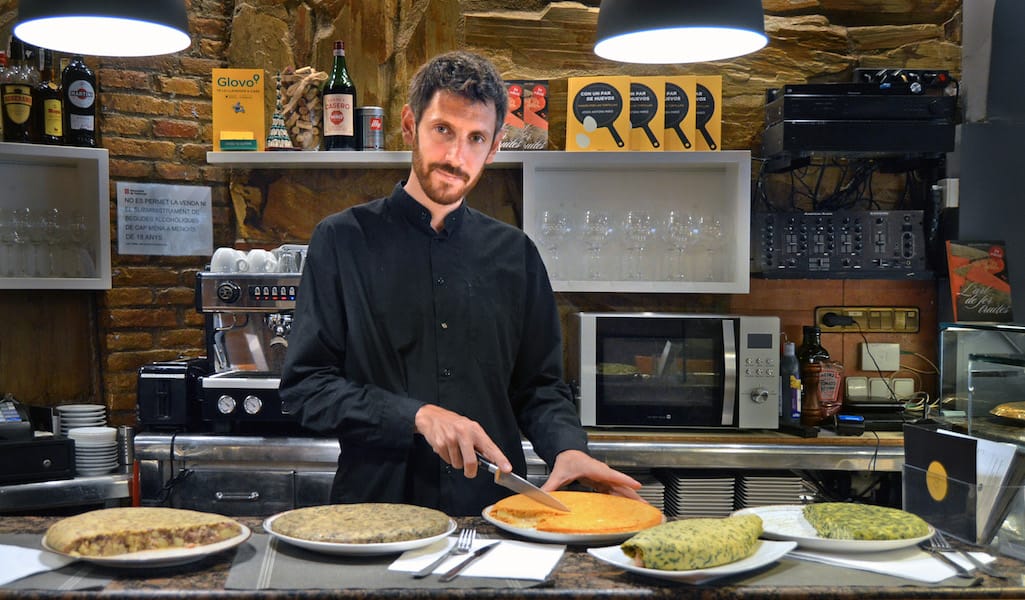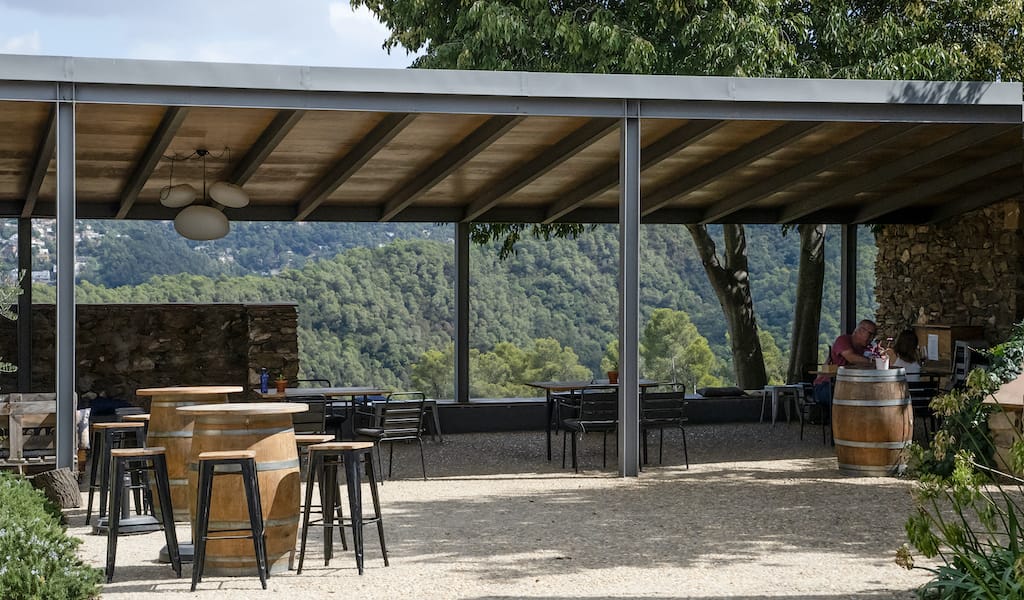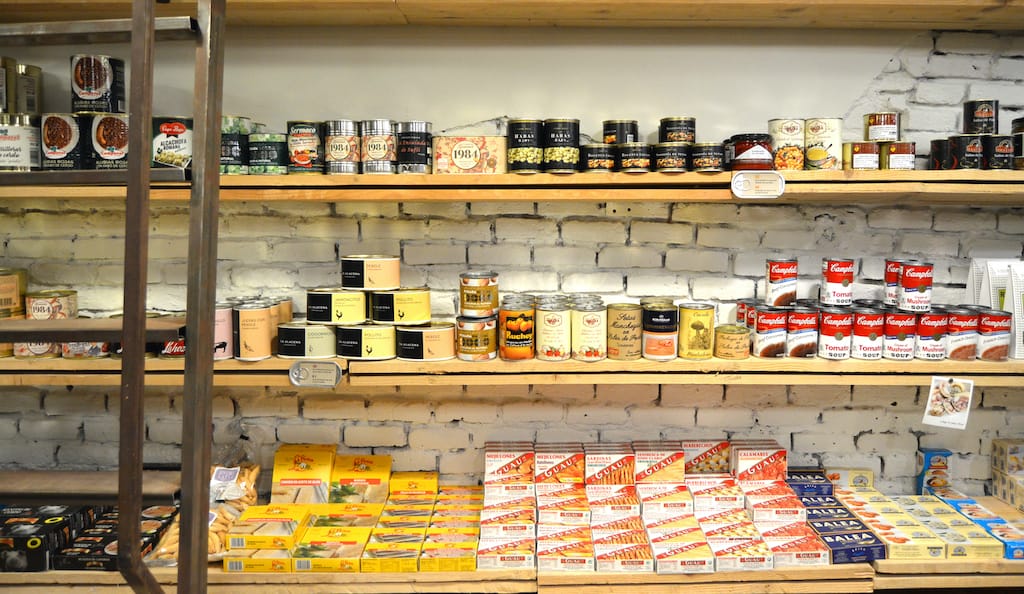Although it would seem that much of the world imagines the inhabitants of Spain subsisting largely on paella, the truth of the matter is that it is the tortilla de patatas (truita de patata in Catalan), also known as tortilla española in some Spanish regions, that really holds the place of honor in the hearts and stomachs of Spaniards.
Often translated into English on menus as “potato omelet,” this hearty round cake of potatoes, eggs, olive oil and salt has nothing to do with the traditional French omelet, nor does it have anything in common with a Mexican tortilla. At its most basic, the Spanish tortilla is made by frying up a thick mass of sliced potatoes and eggs in olive oil and then slicing it into savory wedges.
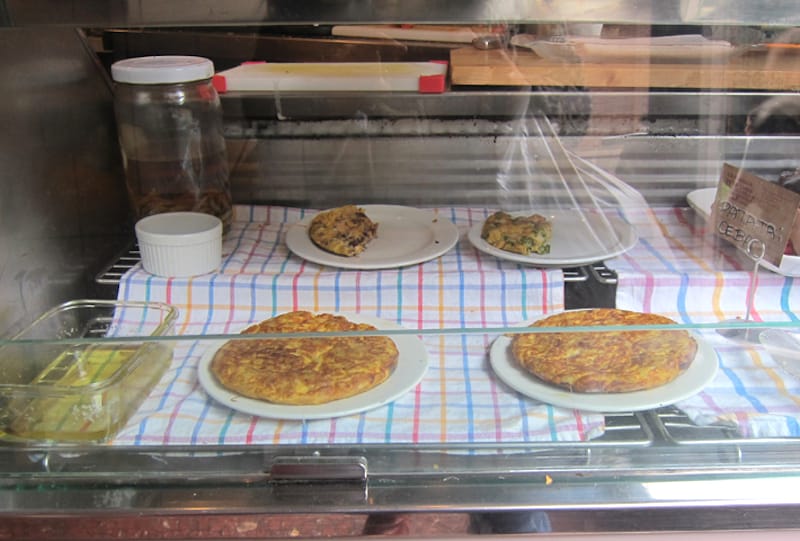
The tortilla is also incredibly versatile and can incorporate a dizzying array of supplementary ingredients, including (but certainly not limited to): onion (the most typical versions include onion fried either with the potatoes or caramelized on their own), green or red chiles (which are generally not spicy), garlic, spinach, leeks, zucchini, chorizo or jamón serrano. Besides these extra ingredients, there are identical versions of a Spanish tortilla that directly substitute the potatoes for other vegetables, like eggplant, artichokes, cod or butifarra (Catalan sausage). These are often made the same way as a potato tortilla, and may even look the same, but they are considered a different dish altogether.
Tortilla can be eaten for breakfast, lunch, dinner or a snack, and not only will you see it in every tapas bar you pass, but it also makes appearances on school lunch menus (at the rate of at least once per week), at birthday parties and at picnics. You will even see this already carb-heavy dish frequently stuffed between two slices of bread and served as a sandwich! In short, it is the ultimate go-to comfort food and the dish that Spaniards throughout the country most associate with home.
The origin of this humble dish seems to be around the 17th century, after the elemental tuber arrived from the Andes onto the peninsula (and across all of Europe) a century before, and became integrated into the cuisine. In a 2017 Twitter thread, culinary journalist Ana Vega shared copies of a fascinating document from 1767: an agricultural encyclopedia written by Jose Antonio Valcarcel, General Agriculture and Farmhouse Government. In it, he writes: “[potatoes] are regularly used in Spain in stews and omelets.” Just like that, the potato omelet had become the most usual thing for a Spanish table.
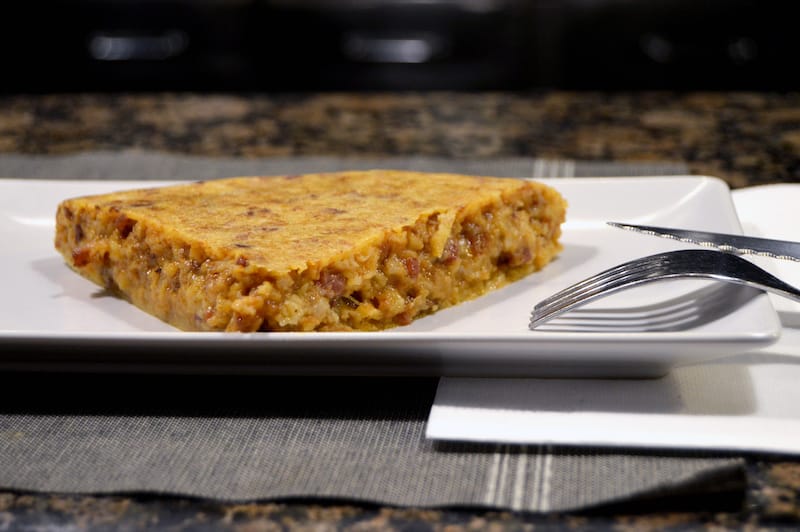
To illustrate even more the omelet evolution, a professor of the Spanish National Research Council (CSIC), Javier López Linaje, published in his 2008 book La patata en España: Historia y Agroecología del Tubérculo Andino a recipe documented in a 1798 magazine on agriculture. The article, published in Extremadura’s city of Villanueva de la Serena, is titled Letter about the potato bread, and mentions a primitive mixture of wheat flour (which was expensive) and potatoes (cheap), that could be combined with egg (fairly easy to come by) and fried up with a little oil in a pan (a more popular tool than the oven), to create an accessible remedy to stave off starvation. Another document, this one from 1817 in Navarra, mentions combining breadcrumbs, potatoes and eggs, in a dish typically made by farmers. The rest is evolution. But all of these are true ancestors of the current, glorious versions of the tortillas that abound in Spain.
While potatoes were introduced in the 16th century in Spain from the South American continent, the Spanish word “tortilla” was exported at the same time to the other side of the Atlantic, meaning small flat breads. The dish was first known in Spain because of the Arabian contribution of flatbread (like pita), made with wheat flour. These are similar to the iconic Mexican tortillas of corn, which were originally called “tlaxcalli” in náhuatl. In the pan-Hispanic world, “tortilla,” “torta” and “tarta” are references to rounded omelets, flat breads or cakes, depending on the country. These come from the Latin, “torta,” also meaning flatbread.
Tortilla can be eaten for breakfast, lunch, dinner or a snack, and not only will you see it in every tapas bar you pass, but it also makes appearances on school lunch menus, at birthday parties and at picnics.
So we know how long tortilla has been made, but what makes it good? Of course, the answer depends on personal taste and everyone will tell you something slightly different. There are debates on everything from whether or not a tortilla should include onions, how the potatoes should be sliced (in thin rounds or in chunky squares), to just how runny the eggs in the middle should be – with some liking their tortillas un poco crudito (a little undercooked) and others preferring a more well-done version. Here are some general rules, however: at bars where the tortilla is displayed on the counter, the egg is totally cooked. At restaurants where the omelet is made to order, the egg is normally runnier. In Andalucía, folks prefer it well done. In Galicia and Euskadi, you will find creamier versions.
This classic Spanish dish is available virtually anywhere that serves food in Barcelona, and it is rare to come across one that falls flat. But there are exceptional versions to be found. Here are some of our favorites:

Flash Flash: The iconic Flash Flash is probably the city’s most famous tortillería with a truly unique “artsy” atmosphere. Opened in 1970 by fashion photographer Leopoldo Pomés and his wife, the restaurant (located in the upper Eixample) was for decades a reference point for the modern restaurant concept, as well as a refuge for the local artistic bourgeoisie and intellectuals. They serve an astounding 70 varieties of tortilla, including ingredients such as morcilla (blood sausage), artichokes, black truffles and potato chips. (If in doubt, order the Catalan classic tortilla de samfaina, with a filling similar to ratatouille.) Stepping into Flash Flash – with its spare black-and-white color scheme and enormous vintage photos of Pomés’s model wife covering the walls – is like being time-warped back to the swinging 70s and serves as a reminder that in Spain, the tortilla is really something of a star.
Les Truites: Another temple of tortillas of all kinds. A neighborhood restaurant in Sant Gervasi, Les Truites experiments with new ingredient combos and is always producing more flat, rounded gems. From the most-conventional (mushroom or Iberian ham) to the most-unexpected (octopus, foie gras and even croissant), the variations are always delicious and exciting. In their last 40 years breaking free-range eggs into uncountable tortillas, Joan Antoni Miró and his son Marc have created more than 180 different types.

Taktika Berri: A family-run Basque bar and restaurant in the Eixample Izquierda that makes an especially good tortilla de bacalao (tortilla with cod), but an even better and absolutely proverbial potato omelet, with slow-cook onions and an extremely juicy texture.
Pollería Fontana: This lovely restaurant in Gràcia is where we go when we need to taste the nostalgic flavors of an ideal childhood home. Owner Nil Ros learned his way around a kitchen from a wise old cook known by their clients as “the grandma” or “the godmother.” Nil nails simple pleasures like Pollería Fontana’s perfect croquets, and of course, their potato omelets for one: tender, juicy, tasty, anxiolytic and healing in general.
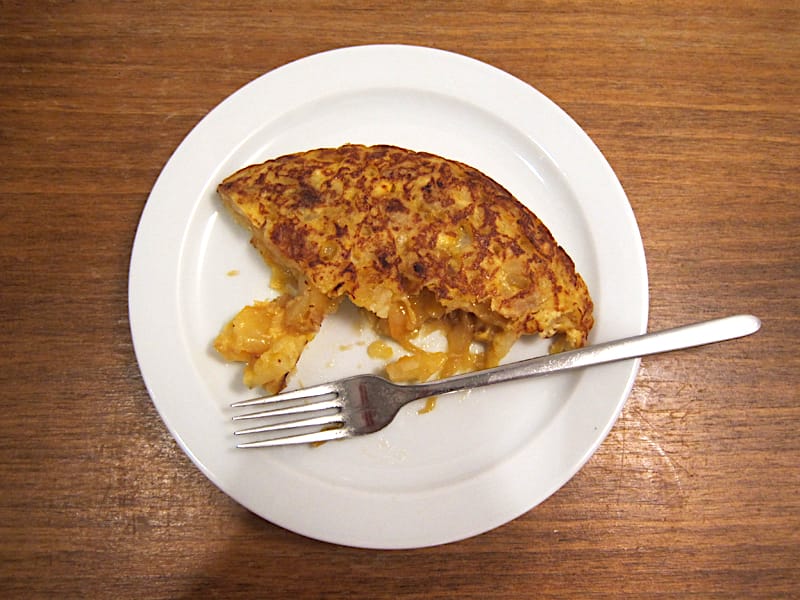
For those not able to make it out to these superb tortilla joints, below is a standard recipe (which includes onion, a must for this author). Our recommendation is to start with a small, quality nonstick pan so you can flip the tortilla easily.
Ingredients
For a large, 8-slice tortilla
8 large eggs
1kg (2 lbs) of potato
1 onion (medium to large)
Olive oil (enough to just cover the potatoes)
Salt to taste
Tools
Frying pan or fryer, for the potatoes
Nonstick skillet, for the omelet (not too heavy, around 20/24 cm diameter, 4-5cm deep)
Slotted spoon or colander
1 plate of the same size or bigger than the pan
Directions
-Warm olive oil in the pan or fryer on low heat while prepping the potatoes.
-Peel, clean and cut the potatoes into small slices of a medium thickness (about 2 cm).
-Julienne the onion into thin slices. Set aside.
-Add the potatoes to the hot oil, and increase the heat to medium. Avoid increasing the heat and let the potatoes fry slowly, as we want them soft, not crispy.
-When the potatoes are just about tender, add in the cut onions.
-While the potatoes and onions are cooking, beat the eggs in a big bowl. Add salt to taste. (We like a pinch of salt for each egg.)
-Continue frying the potatoes until they are soft inside and just beginning to brown. This can take anywhere from 10-15 minutes, so continue to check the potatoes. The onions should be transparent.
-Once the potatoes are soft, you can increase the heat and let them cook for a minute.
-Using a slotted spoon or colander, remove the onions and potatoes from the pan. Allow them to be drained of oil as they cool for about 10 minutes.
-Carefully add the potatoes and onion to the bowl of beaten eggs. Mix. Taste and adjust the salt. Let rest for a couple of minutes. (To make the tortilla creamier, mix the potatoes and eggs vigorously to break down the potatoes and release the starch.)
-Heat the second nonstick pan on medium-high heat with a little bit of extra virgin olive oil to coat the bottom.
-Heat the pan on medium and pour in the potato and egg mixture. After about 3 minutes, tilt the pan to make sure the contents are not sticking to the bottom.
-When the edges of the omelet are cooked and the center is still liquid (around 5 minutes), place a plate over the pan. Keeping your hand on the dish, carefully flip the pan so that the tortilla lands on the plate. Gently slide the omelet back into the pan to cook the other side. Repeat as needed. (Tip: Select a pan that isn’t too heavy. You should be able to lift the pan full of potatoes with one hand.)
-Cook the other side of your tortilla, another 3 minutes.
-To serve, flip the omelet in the dish again (choosing the best side for presentation!).
It is perfect with a good side salad and a bit of bread to dip into the creamy egg inside.
Published on April 01, 2022
Related stories
May 20, 2022
BarcelonaPulpo (octopus) is more than just a staple food in Galicia (the autonomous community in northwest Spain); it is an icon, a national symbol venerated by Galicians as well as Spaniards across the country. In Galicia, this cephalopod is consumed at traditional village fairs, and is sold on weekends at street stalls. These stands are…
September 15, 2022
BarcelonaIt has been an endless summer in Barcelona. The temperatures are historically high and use of public air-conditioning historically low due to government-imposed energy saving measures. We are learning to live with what looks like a constant heat wave, where the best hours of the day start at night. The city is now recovering its…
June 24, 2022
BarcelonaIn Spain, conservas, or foods preserved in cans and jars, are not simply a matter of economic survival or a source of basic nutrition for students, hikers, military recruits and the like. Rather, the tradition of conservas more resembles that of keeping one’s most beautiful jewelry locked safe in a strongbox – a prized possession…







































